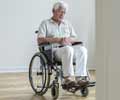Surgeons from UC Davis Medical Centre have used artificial muscles to restore the ability of patients with facial paralysis to blink, in what is a major advance in this field.
Surgeons from UC Davis Medical Centre have used artificial muscles to restore the ability of patients with facial paralysis to blink, in what is a major advance in this field.
The new study is believed offer a ray of hope to people who no longer are able to close their eyelids due to combat-related injuries, stroke, nerve injury or facial surgery.The technique called electroactive polymer artificial muscle (EPAM) uses a combination of electrode leads and silicon polymers that could be used to develop synthetic muscles to control other parts of the body.
"This is the first-wave use of artificial muscle in any biological system," said Travis Tollefson, a facial plastic surgeon in the UC Davis Department of Otolaryngology - Head and Neck Surgery.
"But there are many ideas and concepts where this technology may play a role," he added.
During the study, lead researchers Tollefson and Craig Senders used an eyelid sling mechanism to create an eyelid blink when actuated by an artificial muscle.
Using cadavers, they inserted a sling made of muscle fascia or implantable fabric around the eye.
Advertisement
The surgeons found that the force and stroke required to close the eyelid with the sling were well within the attainable range of the artificial muscle.
Advertisement
A similar system also could give children born with facial paralysis a smile.
The new procedure is described in the Archives of Facial Plastic Surgery.
Source-ANI
RAS














